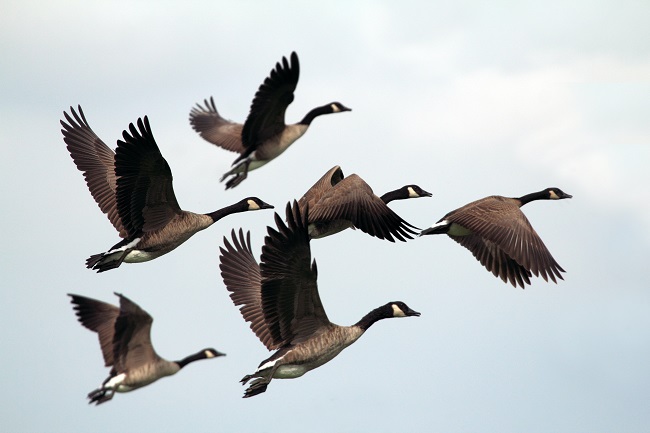
The Canada Goose (Branta canadensis) is an iconic waterfowl species that has captured the imagination of bird enthusiasts and nature lovers around the world. With its distinctive black head, white cheek patches, and signature honking call, this graceful avian creature is a symbol of wilderness and resilience. From its native habitats to its impressive migration habits and ecological significance, the Canada Goose is a remarkable species that exemplifies the wonders of the natural world.
Native Habitats and Range
The Canada Goose is a species native to North America and can be found throughout a diverse range of habitats. These include wetlands, lakes, rivers, and grassy fields, where they feed on aquatic plants, grasses, and grains. They are highly adaptable birds and have even managed to thrive in urban environments such as parks, golf courses, and agricultural fields.
Their range spans across North America, from the Arctic tundra to the southern United States. The remarkable adaptability of Canada Geese has allowed them to establish populations in both rural and urban settings, becoming a common sight in many regions.
Migration Habits
One of the most awe-inspiring aspects of the Canada Goose is its migratory behavior. Many Canada Goose populations are migratory, traveling incredible distances between their breeding and wintering grounds. Some Canada Geese are known to travel up to 3,000 miles during migration.
These geese are known for their characteristic V-shaped formations while flying, which serves a functional purpose. The V-formation reduces air resistance and conserves energy, allowing the geese to travel long distances more efficiently. Additionally, it is believed that the formation enables better communication among the birds.
High-Altitude Flying Abilities
One of the most intriguing features of Canada Geese is their ability to fly at high altitudes, including altitudes that might surprise many. While the exact altitude they can reach might vary, there have been documented instances of Canada Geese flying at altitudes of 29,000 feet or even higher. This remarkable feat showcases their adaptation to various environmental conditions.
At such high altitudes, the air is thin, and temperatures can drop to extreme levels. To survive these conditions, Canada Geese have evolved physiological adaptations that allow them to extract oxygen efficiently and maintain body temperature. Their ability to fly at these heights is a testament to their resilience and adaptability.
Role in the Ecosystem
Beyond their migratory journeys and high-altitude flights, Canada Geese play a crucial role in the ecosystems they inhabit. As herbivores, they help control the growth of aquatic plants in wetland habitats, preventing overgrowth that could harm the ecosystem. Their feeding habits also stir up sediment and nutrient cycling in water bodies, benefiting other aquatic life forms.
Furthermore, Canada Geese are an important part of the food chain. They serve as prey for various predators, including eagles, foxes, and coyotes. Their presence contributes to the overall biodiversity of their habitats.
In urban environments, Canada Geese can sometimes be seen as a nuisance due to their large populations and associated waste. However, they remain an essential part of the natural world, showcasing the adaptability of wildlife to changing landscapes.
Conclusion
The Canada Goose is a remarkable species that exemplifies the marvels of nature’s adaptability, migration, and ecological roles. From their diverse native habitats to their astonishing migration journeys and high-altitude flights, these birds inspire awe and fascination.
10 Fun Facts About the Canada Goose
Diverse Vocalizations: While the classic “honk” is the most recognizable call of Canada Geese, they can produce a wide range of vocalizations, including barks, murmurs, and hooting sounds. These sounds are used for communication among flock members and to establish dominance or signal danger.
Monogamous Relationships: Canada Geese are known for forming strong monogamous bonds with their mates. These bonds can last for many years, and in some cases, even for life. They often return to the same nesting sites year after year.
Protective Parents: Canada Geese are fiercely protective parents. Both the male and female take on the responsibility of guarding the nest and protecting their young goslings from predators. They will often hiss, flap their wings, and display aggressive behavior if they feel their offspring are threatened.
Molting Period: During the molting period, which usually occurs in the summer, Canada Geese temporarily lose the ability to fly as they shed their flight feathers and grow new ones. This is a vulnerable time for them, and they often seek out safe areas near water where they can stay protected until they can fly again.
Flying in Formation: The V-shaped flying formation of Canada Geese not only reduces air resistance but also helps them maintain visual contact with one another. The lead goose experiences the most air resistance, so the geese take turns at the front, allowing the group to share the effort of flying.
Long Lifespan: Canada Geese have relatively long lifespans in the wild, often living from 10 and up to 24 years. In captivity, they can live even longer.
Global Distribution: While they are native to North America, Canada Geese have been introduced to other parts of the world, including Europe and New Zealand. Some of these introduced populations have become established and even exhibit migratory behavior like their North American counterparts.
Feeding Habits: Canada Geese are primarily herbivores, grazing on grasses, aquatic plants, and grains. Their diet can vary based on the availability of food in their habitat.
Population Growth: Due to their adaptability and ability to thrive in various environments, some Canada Goose populations have experienced significant growth. This has led to conflicts in some urban areas due to their grazing habits and waste accumulation.
Subspecies Diversity: There are several recognized subspecies of Canada Geese, each with its own unique characteristics and range. For example, the smaller “Cackling Goose” is often considered a subspecies of the Canada Goose.
Related Articles & Free Email Newsletter Sign Up
How Hummingbirds Play a Vital Role in Your Yard and Garden
Loon: The Iconic Bird Species of Tranquil Lakes
Unveiling the Allure of the Bird of Paradise: Nature’s Extravagant Performer


Comment here